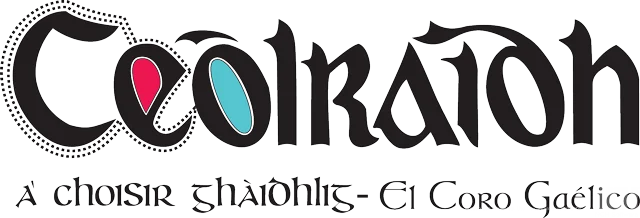We are an Argentine choral group dedicated to singing solely in Scottish Gaelic; Spanish is our mother tongue. While only one member is a Gaelic speaker, others are students of the language and sing phonetically.
Since the creation of Ceòlraidh, which started as part of the Gaelic language courses taught by Guillermo Santana MacKinlay, the language has been very important to us: we specially focus on its correct accent and pronunciation to stay true to the spirit of the songs, even when these were not originally composed for a choir.
We count on our Gaelic Language and Culture Director to help us frame the songs in their historical and cultural context. This is of crucial importance since our audience does not understand the Scottish Gaelic, and we also offer a short account of every song in our repertoire.
We divide the selection and interpretation of the repertoire into two groups: rhythmic songs (dances, working songs, etc.) and poetic, interpretive songs in order to achieve variety and diversity of styles in our performances.
We work on rhythmic songs as follows: if they are working songs, we perform the action involved all together as a group (rowing, walking the cloth, etc.) to represent these activities, required by this type of work. If they are dances, we work with our dance on the speed and rhythm of the song so that it can be sung and danced. The choral arrangement are unelaborated, usually sung in unison or accompanied by musical instruments, such as the small pipe, the guitar, the bodhran, which are also played by choir members.
For the rhythmic songs that do not imply dancing or working to them, the musical arrangement is more sophisticated, but rhythm plays an important role in the interpretation.
As for the group of more poetic, interpretive songs, language is paramount. The vocal arrangement is more complex, involving several voices and using different resources to achieve intensity and expression.
These songs pose many a challenge; the most usual one being the length of the verses. As a rule, we choose a sufficient number of verses to tell a story, without neglecting the interpretation and at the same time, making sure that is enjoyable for an audience that does not understand the language.
Another difficulty we face is the changing metre from one verse to another, for which upbeat or passing notes are introduced in order to give the words their proper stress in Gaelic.
Working on the Gaelic language, its intrinsic rhythm, accent, and pronunciation is essential for these songs to convey an idea of the richness, subtleties, depth and beauty of the language and its music, which are enduring images of the Scottish Gaelic culture throughout the ages to this present day.
Claudia Cano
She is the conductor of the Coral Group ’Ceolraidh’, which performs traditional Scottish Gaelic music. She is also the conduuctor of the Group ’Reencuentro Coral‘, a seniors’ choir, whose main repertoire is drawn from traditional tunes.
She is also the vocal trainer of the Coral Nemus choir, whose repertoire ranges from Renaissance to contemporary popular music. She also sings in Coral Nemus in the contralto range.
She was a member of the Atmen Vocal Group, whose repertoire focuses on ancient music. Additionally, she sang in Atmen Vocal Group in the mezzo soprano range.
She teaches vocal preparation at ETER. Since 2003 she has been teaching private singing lessons.
She studied composition at “Sebastián Piana” Composing Institute, guitar with Rafael Pérez Lazarte and Diego Zocco, singing with Kanky Kozameh. She has also been studying singing with Elisa Viladesau since 2004.
He did various training courses related to her activity:
- Vocal improvisation workshop, given by Paul Dutton (Canada).
- Functional voice education, Rabine Method, by Renata Parussel (Argentina).
- Vocal preparation for group singing, by Javier Sotelo (Argentina).
- Functional voice education, Rabine Method, by Prof. Gottfriend Hoffmann (Germany).
- Functional voice education, Rabine Method, by Professors Roland Seiler and Armin Fuchs (Germany).
- Functional voice education, Method Rabine, by the members of the Vocal Work Center (Argentina).
- Functional voice education, by Professor Eugene Rabine (Germany).
- Further training courses for singing teachers, by Elisa Viladesau (Argentina).
- In 2014, she travelled to Germany to take classes at the Rabine-Institut, taught by Professor Eugene Rabine.
Guillermo Santana MacKinlay
Guillermo Santana MacKinaly is the Gaelic Language and Culture Director of Ceòlraidh and one of its founding members.
During his childhood, he taught himself the language of his Scottish forbearers and later travelled to Scotland to study at the Sabhal Mòr Ostaig in Skye. He later went to Canada to attend The Nova Scotia School of Gaelic Arts and Crafts.
He has completed other courses, like Cuir Peann ri Pàipear, Gaidhlig, Beul-Aithis and Sloinntearachd, and is currently pursuing a Higher Diploma in Gaelic and Related Studies, at the University of the Highlands and Islands of Scotland.
He has given several conferences and dissertations at congresses, written articles in magazines and newspapers, and participated in programmes of the BBC Radio nan Gàidheal and in the BBC series Na h-Eilthirich.
He has been teaching Gaelic for beginners in Argentina since 1989.
